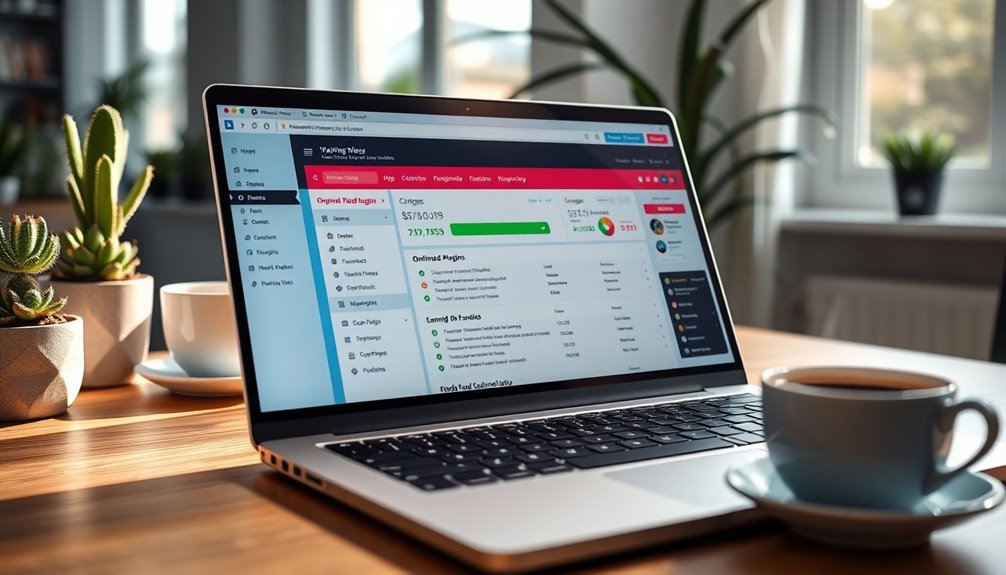Improving your site speed with optimized WordPress plugins is vital for keeping visitors engaged and boosting conversion rates. You should consider plugins like W3 Total Cache for robust caching, WP Smush for image compression, and Autoptimize for minifying files. It's essential to monitor performance using tools like Google PageSpeed Insights and regularly update your plugins to avoid slowdowns. By following these strategies, you can markedly enhance your site's speed and effectiveness. Plus, there's more to explore on this topic!
Why Speed Optimization Is Essential for Your Website
When you consider the impact of site speed on user experience, it becomes clear why speed optimization is crucial for your website. A mere 1-second delay in page load times can lead to a 7% drop in conversion rates, which is significant for any website owner.
Google prioritizes site speed in its rankings, so a faster WordPress site can boost your organic traffic. Sites loading in under 3 seconds experience a 32% higher bounce rate, underscoring the need for quick load times. Regularly testing your site speed using performance monitoring tools can help identify areas for enhancement and improve user engagement.
Optimizing for Core Web Fundamentals enhances user satisfaction, leading to longer sessions and repeat visits. Utilizing a caching plugin can be a game-changer in your performance optimization strategy, ensuring your site remains competitive and engaging. Caching plugins significantly speed up WordPress sites and ensure seamless browsing even during high traffic periods. Additionally, employing performance optimization techniques can greatly reduce server strain and improve loading times across your site.
Top WordPress Plugins for Enhancing Site Speed
To achieve ideal site speed on your WordPress website, utilizing the right plugins is essential.
W3 Total Cache offers robust page caching, database, and object caching to greatly improve performance. Regular backups are necessary to protect data from potential loss during the optimization process.
For image optimization, WP Smush automatically compresses images during upload, ensuring faster load times without quality loss.
Autoptimize aggregates and minifies HTML, CSS, and JavaScript files, while also supporting lazy loading functionality for images, enhancing overall speed.
WP Fastest Cache generates static HTML files and features GZIP compression, making page loading quicker.
Finally, integrating Cloudflare as a content delivery network (CDN) distributes your content closer to users, boosting site speed and adding security features. Regular backups safeguard against unforeseen issues and data loss, ensuring your website remains operational and efficient.
These speed optimization plugins are vital for a fast and efficient website.
How to Choose the Right Optimization Plugins

How can you guarantee you're selecting the right optimization plugins for your WordPress site? Start by evaluating your website speed through performance metrics from tools like Google PageSpeed Insights. This will help pinpoint areas needing improvement.
Look for optimization plugins that offer features like cache purge, image compression, and database cleaning to streamline performance enhancements. Confirm these plugins are compatible with your current theme and other plugins to maintain site functionality. Additionally, ensure that you choose plugins with high-level encryption to protect your data during optimization processes. Implementing a comprehensive security strategy will further enhance your site's resilience against potential threats.
User-friendly interfaces and easy setup processes are crucial, especially if you're not technically inclined. Finally, don't hesitate to test different plugins over a month to analyze their impact on Core Web Vitals and overall speed, guiding your decision based on tangible performance improvements. Additionally, consider integrating SEO optimization plugins to further enhance your site's visibility and speed.
Best Practices for Maintaining Plugin Efficiency
To keep your WordPress site running smoothly, you need to regularly update your plugins and limit their usage. Outdated themes and plugins can significantly slow down your site and introduce security risks. Regularly updating your plugins is essential to mitigate common vulnerabilities that can compromise your website's security. Monitor performance metrics to identify any slowdowns caused by inefficient plugins. Additionally, consider utilizing popular form builder plugins to ensure efficient data collection and enhance site functionality.
Regularly Update Plugins
While keeping your WordPress plugins updated may seem like a routine task, it plays an essential role in maintaining your site's speed and security.
When you regularly update plugins, you guarantee compatibility with the latest WordPress version, which helps prevent performance issues and security vulnerabilities.
Each plugin update often includes performance enhancements and bug fixes that can lead to faster load times and a smoother user experience.
Outdated plugins can contribute to site bloat, dragging down your site speed.
Before applying updates, review plugin changelogs to understand their potential impact.
Additionally, testing plugin updates in a staging environment can help prevent conflicts, ensuring peak performance on your live site.
Stay proactive about your updates for the best results!
Limit Plugin Usage
Limiting the number of active plugins is essential for maintaining your WordPress site's speed and efficiency. By minimizing plugin usage, you can improve performance, reduce loading times, and lower server load.
Excessive plugins can introduce poorly coded software that negatively impacts your site speed. Instead, opt for multifunctional plugins, like WP-Optimize, that consolidate features such as caching and image compression to reduce bloat.
Regularly review and uninstall unused or outdated plugins to maintain security and optimize website performance. Remember to verify plugins are updated regularly, as these updates often include performance enhancements.
Always test your site's performance before and after installing new plugins to gauge their impact on loading times and overall efficiency.
Monitor Performance Metrics
Monitoring performance metrics is essential for ensuring your plugins contribute positively to your site's speed. Use tools like Google PageSpeed Insights and GTmetrix to regularly monitor performance metrics, focusing on Core Web Essentials such as Largest Contentful Paint (LCP) and Cumulative Layout Shift (CLS).
These metrics help you assess how plugins and themes affect loading time. Implement a review schedule to update your WordPress optimization plugins, as outdated versions can slow down your site.
Leverage built-in performance monitoring features in plugins like Hummingbird or WP Rocket to track caching effectiveness. Additionally, conduct A/B testing to compare performance before and after optimizations, allowing you to make informed decisions on configurations that enhance site speed.
Testing Your Website Speed Effectively

How can you guarantee your website performs at its finest? Start by regularly testing your website speed with tools like Google PageSpeed Insights and GTmetrix.
These platforms provide insights into loading speed and offer specific enhancement recommendations based on performance metrics. Whenever you add WordPress plugins or update themes, perform a speed test to see how these changes affect load times. Additionally, consider implementing daily backups to prevent data loss that could impact site performance, as regular backups are key to preserving data integrity.
Don't forget to test across different devices and browsers to confirm consistent performance. It's also wise to assess your site's speed during peak traffic hours to uncover potential bottlenecks.
Finally, keep an eye on your Core Web Vitals, such as Largest Contentful Paint (LCP) and Cumulative Layout Shift (CLS), to maintain an ideal user experience. Additionally, ensure that you have a robust backup strategy in place to safeguard your site against potential speed issues caused by data loss or corruption.
Common Mistakes to Avoid in Speed Optimization
When optimizing your site's speed, it's essential not to overlook image optimization—uncompressed images can drag down your load times considerably.
Also, be cautious about overusing plugins; too many can slow your site and strain your server.
Finally, if you're neglecting caching strategies, you're missing out on a key way to enhance your site's performance. Additionally, ensuring strong passwords can help secure your site against unauthorized access, which is crucial for maintaining overall site integrity and performance.
Ignoring Image Optimization
While you may focus on various aspects of site speed optimization, neglecting image optimization can severely undermine your efforts. Unoptimized images can account for up to 80% of a webpage's total weight, drastically slowing page load speed.
Tools like WP Smush allow you to compress images upon upload or perform bulk optimization on existing files, reducing sizes by up to 85% without sacrificing quality. Additionally, using formats like WebP can greatly decrease image sizes, which is essential for maintaining speed, especially on mobile devices.
Regularly optimizing images not only enhances user experience but also improves your Google PageSpeed Insights scores, a vital factor for SEO and user engagement.
Don't overlook this important element in your optimization strategy!
Overusing Plugins
Neglecting image optimization can lead to a false sense of security about your site's speed, but overusing plugins can be just as detrimental. Each additional plugin you activate increases HTTP requests, which can slow your website considerably.
A study found that sites with excessive plugins experienced a 50% decrease in loading times. To optimize WordPress effectively, you should limit your active plugins to around 20. This helps maintain functionality while improving performance and reducing server load.
Regular review of your plugins is essential; disabling unused ones can dramatically enhance site speed. Remember, fewer, well-coded plugins can help you achieve faster loading times and ultimately improve your website's overall performance.
Neglecting Caching Strategies
Caching strategies are essential for optimizing your site's speed, yet many site owners overlook their importance. Failing to implement proper caching can lead to slower page load times, as dynamic content generation increases server load.
Not configuring cache lifespan settings means users might encounter stale content, which can confuse them and hurt engagement. Additionally, ignoring cache preloading can cause your first visitors to experience delays since cached pages won't be ready immediately.
Don't forget to regularly clear the cache to prevent outdated content from being served. Finally, guarantee compatibility with e-commerce plugins like WooCommerce; neglecting this can lead to errors that affect transactions and customer trust, ultimately slowing down your site.
Future Trends in WordPress Speed Optimization Plugins

How will the future of WordPress speed optimization plugins shape your site's performance? Expect significant advancements that enhance your site's loading speed and user experience.
Here are four key trends to watch:
- AI Integration: Automated performance adjustments based on real-time user behavior will optimize loading times.
- Core Web Essentials Focus: Plugins will prioritize metrics that impact SEO, eliminating render-blocking resources.
- Serverless Architecture & Edge Computing: Expect faster content delivery via distributed networks, reducing latency.
- Image Optimization: Adoption of WebP and AVIF formats will minimize file sizes without sacrificing quality.
With these innovations, your API-driven sites will see improved performance and optimized content delivery, making WordPress speed optimization easier and more effective than ever.
Conclusion
To sum up, optimizing your site's speed isn't just a nice-to-have—it's essential. Did you know that a one-second delay in loading time can lead to a 7% loss in conversions? By choosing the right WordPress plugins and following best practices, you can greatly enhance your website's performance. Remember to regularly test your site's speed and avoid common pitfalls. Stay ahead of the curve to keep your visitors engaged and satisfied with every click!



